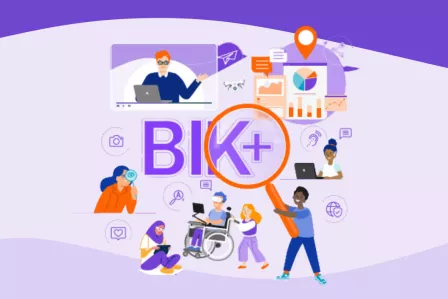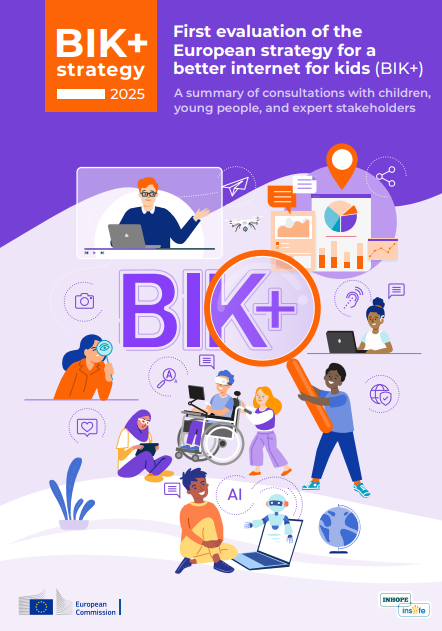On Safer Internet Day 2025, the European Commission has released the first evaluation report of the Better Internet for Kids (BIK+) strategy, a review of the EU’s commitment to creating a safe and empowering digital environment for children and young people.

This evaluation, the first of its kind, draws on insights from 759 children and young people across Europe, including those from vulnerable backgrounds and 59 expert stakeholders from academia, industry, civil society, and policy.
The report highlights both the successes and challenges of the strategy since its adoption on 11 May 2022, offering key recommendations for improvement.
Key findings
The key findings of the report are:
- Children’s and young people’s experiences: While efforts to create safer online spaces were appreciated, young people continued to face exposure to harmful content, privacy violations, and online scams. They call for clear and concise policies and procedures.
- Inclusivity and accessibility: The digital divide remains a concern, with children from rural areas and vulnerable backgrounds facing barriers to online participation as well as difficulties in reporting harmful content.
- Digital empowerment: Many children and young people struggle to identify disinformation and scams, highlighting the need for enhanced digital education and stricter rules for industry.
- Active participation: Young people expressed strong interest in being more involved in shaping digital policy and online services, calling for youth advisory boards and regular engagement with tech companies and policymakers.
- Expert stakeholder insights: Stakeholders emphasised the need for better regulatory alignment across EU Member States, cross-sector collaboration, and long-term research into digital impacts on children’s well-being.
Recommendations for action
- Improving reporting mechanisms: Make it easier for children to report harmful content with clearer steps that take up less time and swift and detailed feedback.
- Enhancing digital education: Implement comprehensive and age-appropriate digital literacy programmes into school curricula.
- Fostering youth participation: Establish structured platforms for children to contribute to policymaking and developing digital services.
- Addressing expert-identified gaps: Act on the recommendations from expert stakeholders. Longitudinal studies on the long-term effects of the digital transformation on children’s and young people’s well-being should be conducted, regulatory frameworks across the EU should be simplified, and cross-sector partnerships should be strengthened to improve digital safety and inclusivity.
Looking ahead
This evaluation marks a significant step forward in understanding how the BIK+ strategy is shaping the online world for young people. However, it also highlights that much more must be done to keep young people online safe and empowered. In the coming months, this report will be expanded with insights from parents, caregivers, teachers, and educators, followed by a family-friendly short report and visual outputs.
Read the full BIK+ strategy evaluation here or by clicking the image below.

On Safer Internet Day 2025, the European Commission has released the first evaluation report of the Better Internet for Kids (BIK+) strategy, a review of the EU’s commitment to creating a safe and empowering digital environment for children and young people.

This evaluation, the first of its kind, draws on insights from 759 children and young people across Europe, including those from vulnerable backgrounds and 59 expert stakeholders from academia, industry, civil society, and policy.
The report highlights both the successes and challenges of the strategy since its adoption on 11 May 2022, offering key recommendations for improvement.
Key findings
The key findings of the report are:
- Children’s and young people’s experiences: While efforts to create safer online spaces were appreciated, young people continued to face exposure to harmful content, privacy violations, and online scams. They call for clear and concise policies and procedures.
- Inclusivity and accessibility: The digital divide remains a concern, with children from rural areas and vulnerable backgrounds facing barriers to online participation as well as difficulties in reporting harmful content.
- Digital empowerment: Many children and young people struggle to identify disinformation and scams, highlighting the need for enhanced digital education and stricter rules for industry.
- Active participation: Young people expressed strong interest in being more involved in shaping digital policy and online services, calling for youth advisory boards and regular engagement with tech companies and policymakers.
- Expert stakeholder insights: Stakeholders emphasised the need for better regulatory alignment across EU Member States, cross-sector collaboration, and long-term research into digital impacts on children’s well-being.
Recommendations for action
- Improving reporting mechanisms: Make it easier for children to report harmful content with clearer steps that take up less time and swift and detailed feedback.
- Enhancing digital education: Implement comprehensive and age-appropriate digital literacy programmes into school curricula.
- Fostering youth participation: Establish structured platforms for children to contribute to policymaking and developing digital services.
- Addressing expert-identified gaps: Act on the recommendations from expert stakeholders. Longitudinal studies on the long-term effects of the digital transformation on children’s and young people’s well-being should be conducted, regulatory frameworks across the EU should be simplified, and cross-sector partnerships should be strengthened to improve digital safety and inclusivity.
Looking ahead
This evaluation marks a significant step forward in understanding how the BIK+ strategy is shaping the online world for young people. However, it also highlights that much more must be done to keep young people online safe and empowered. In the coming months, this report will be expanded with insights from parents, caregivers, teachers, and educators, followed by a family-friendly short report and visual outputs.
Read the full BIK+ strategy evaluation here or by clicking the image below.

- Better Internet for Kids (BIK+) strategy Safer Internet Day (SID)
Related content
- < Previous article
- Next article >











